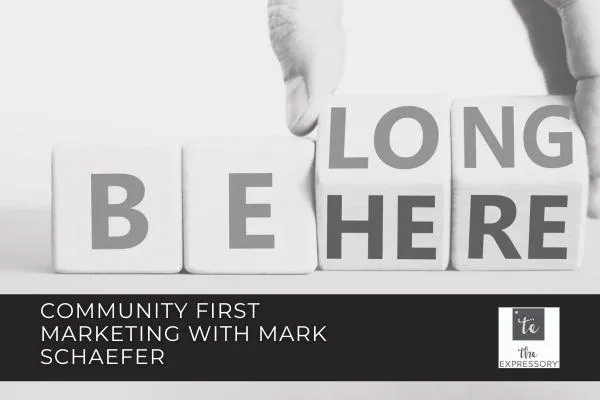

What Swimming Teaches Us About Team Relationships
In my latest video, I break down how swimming teaches us the importance of these relationship-building efforts and the specifics of what we as leaders need to nurture with our teams.
Holiday Gift Insights - What Everyone Else Is Doing
In an effort to simplify the decision-making process, we're sharing some of the trends we've seen with gifting over the years. We're even sharing our best seller and why that gift had such success.
What Makes A Successful Holiday Gift? The Travel Bag Edition
Last year we had the opportunity to work with one of our clients in the travel and tourism space to design an experience that delivered their highest engagement yet.

Community First Marketing with Mark Schaefer
Ever listen to an interview and think – That was meant for me to hear? That’s the way I felt when I first heard Drew McLellan interview Mark Schaefer on his Build a Better Agency Podcast. During their interview, Schaefer was discussing insights from his book, Belonging to The Brand – Why Community is the Last Great Marketing Strategy. His chat with McLellan was so spot-on, and struck a deep chord with my own beliefs, that I had to grab a copy for myself.
It was after promptly devouring the book that I knew I needed to talk with Mark myself. Belonging To the Brand isn't your typical marketing jargon-filled read. It's all about how the traditional way of marketing just isn't cutting it anymore.
Schaefer is the author of 10 books. He’s a globally recognized marketing consultant, speaker, blogger, and podcaster, who also happens to teach graduate marketing courses at Rutgers University. For me, the opportunity to talk with him was more than just a chance to ask questions about the book, but to also explore the intricacies that so many overlook or dismiss. The shift away from conventional methods to a more human-centric approach is not just a trend but a necessity in our digitally connected world. This blog is based on real talk with someone who has lived and breathed this stuff for years.
The Trends That Changed Traditional Marketing
If you’ve heard me speak, you know that I talk to the belief that there are two big trends colliding to disrupt how we conduct business. Similarly, Schaefer believes there are two trends that are coming together to point to community being the future of marketing.
The first trend he references is that traditional marketing isn’t working the way it used to. “We’ve done the same thing that we’ve done for years and years and years, and we haven’t looked up to see that the world works a lot differently,” Schaefer told me. In today’s world customers have access to the collective knowledge of the world right at their fingertips. They don’t want us to sell them the way we used to. In fact, consumers pay good money to avoid marketing with streaming services these days. They expect something different from us in exchange for their engagement, attention, and loyalty.
The second trend he references is the same one you’ll find in our previous blogs, that the world is suffering from loneliness, depression, and isolation more than ever.
As the Surgeon General’s 2023 report shared, one out of two Americans feel lonely. While we are more digitally connected than ever, that has had an unexpected negative impact on our social connectivity. According to the Epidemic of Loneliness, people report feeling “isolated, invisible and insignificant.” There is a clear craving to be seen, to be heard, and to belong to something.
Schaefer’s deep belief is that we need community now more than ever.
“We participate in communities because we have an expectation of status, that we’re going to be heard, that we’re going to be seen, maybe we’re going to even be liked or loved in a community,” said Schaefer. “That’s why we go. That’s why we stay.”
Establishing a Community
In Belonging to The Brand, Schaefer says “When customers belong to your brand, they’ll stick with you in hard times, spend more and spread your story better and farther than any advertising you could ever buy.” Isn’t that what we’re all looking for in this world of business?
So how do we get there?
In the book, Schaefer establishes the framework for creating a community for your brand. It begins with the decision to create a culture from top to bottom that aligns with cultivating a community-first attitude. You must make sure to set the internal expectations that this will be a no selling and marketing zone. This is purely about creating a safe place for your right-fit connections to belong. The benefits come down the road.
Your next step is to create a purpose for the community to exist in the first place. To belong, people need to share similar interests or values. Chances are your brand already has a purpose that could serve the community as well. You want something meaningful and inspiring so that people want to be part of that space. The book has several ideas to help you form a purpose if you need some inspiration.
Once you have the right mindset established and the purpose, it’s time to start gathering your community. You can promote your community on your existing platforms (website, emails, social) and you can even get your current participants involved in bringing in more members. Know that this part takes time, and it often starts small and expands slowly. The founding members are often the most influential and help you expand.
The New Metrics of Engagement and Relevance
Knowing that there is a drastic shift in marketing and hearing that community building has greater potential than most current advertising, it’s a wonder that more aren’t focused on cultivating a community of their own. Schaefer tells me that “viewing it as a brand strategy is almost completely overlooked by businesses today.”
One of the reasons this strategy has not been broadly implemented is that, unlike traditional marketing, in this model, you must be willing to give up power and trust the community to self-lead. That is extremely hard for company leaders to do. For most Type A personalities (control), this just isn’t going to be a fit.
The true power from a community comes when it is self-leading, and you can sit back and collect the learning and guidance from the collective mind of the group. Things you may discover include:
What will keep your brand relevant as the world continues to change?
New customer pain points.
New uses or needs for your product or service.
Relevant current events that may inform your content, product, or services.
What your customers are willing to buy or how to reach them.
You must trust that the community will evolve to serve you in a way that’s needed. People are not there to be marketed to, manipulated, or sold to. They are there to be heard and be part of a conversation they believe in. Your focus needs to remain on creating a safe place for those conversations to take place and for people to feel valued. Not revenue from the community.
And that leads to one of the other key reasons communities are tough to implement. According to Schaefer it’s really hard to measure and that is something you’ll continually have to address with leadership. Brand marketing is more about creating an emotion. It’s what separates you from your competitors. People want to be part of your space because of how you make them feel. It’s the same with a community.
“It’s building that emotional connection,” said Schaefer. “If people are in a community, and they make friends there – Are they ever going to leave that community? If they leave the brand, that means leaving their friends, they literally belong to the brand, you’re creating a layer of emotional switching costs.”
The number one metric in any community is not going to be sales or referrals. It’s engagement. Schaefer said, “Because engagement shows they’re [the brand] relevant. And that’s the number one goal of marketing: relentless, continuous relevance.”
Measuring the number of interactions with the conversation, the products, stories with each other in the community – that’s a valuable measure of brand relevance and will be an indicator for increasing sales.
As noted in the book: “There’s a new truth in the marketing world today: You can either keep up with the pulse of culture, or you can measure. You probably can’t do both.”
Do you believe in the power of community? At The Expressory, we believe we serve a greater purpose – To inspire organizations to invest in meaningful and lasting relationships that not only boost business success, but also contribute to societal wellness. And we have been laying the foundation of a community that believes the same thing. It takes time to get the pieces into place and there isn’t a direct correlation to the success of our conversion or retention, but I can’t tell you the number of times people have thanked me for the discussions we’re having in that community space. Or the times that people have shared that they’ve been inspired to implement something we discussed. I believe that there is more momentum behind our efforts as strategic engagement experts as a result of cultivating that community. And I believe it’s making a difference for the people investing their efforts to be more meaningful about their relationships as well. I have no doubt that a community building strategy would have comparable results for your brand, if you should choose that path.
I invite you to Join one of our monthly Q&A sessions to experience our community for yourself. Let’s keep the conversation flowing to inspire others to create spaces for belonging to their brand.
Address:
1500 S. Sylvania Ave #106
Sturtevant WI 53177
Phone:
414.243.8971
